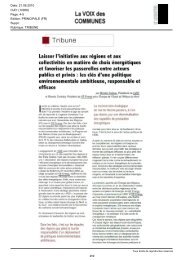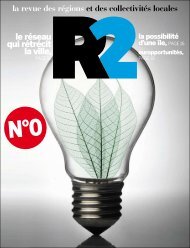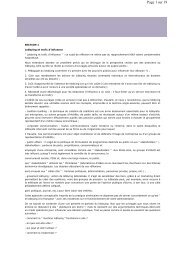GE ENErGy - Frank Farnel
GE ENErGy - Frank Farnel
GE ENErGy - Frank Farnel
You also want an ePaper? Increase the reach of your titles
YUMPU automatically turns print PDFs into web optimized ePapers that Google loves.
INdIA<br />
RENEwaBLE ENERgY<br />
INdIA’S GrEEN FUTUrE<br />
India is making renewable energy a priority and opening a new market for<br />
suppliers. Kishore Jayaraman, President and CEO, <strong>GE</strong> Energy India, bangladesh<br />
and Sri Lanka, talks about the stakes for <strong>GE</strong> and EPC companies.<br />
Kishore Jayaraman,<br />
President and<br />
CEO, <strong>GE</strong> Energy<br />
India, bangladesh<br />
and Sri Lanka<br />
w<br />
ith its spectacular economic<br />
growth, one thing<br />
is clear: India needs<br />
power. In order to keep India’s<br />
development humming, the country<br />
intends to increase its generation<br />
capacity by nearly 80% by<br />
2012.<br />
“The Indian government has set<br />
specific targets for renewable<br />
energy: by 2012 it expects renewable<br />
energy to make up 10% of<br />
total power-generation capacity<br />
and have a 4% to 5% share in<br />
the electricity mix,” says Kishore<br />
Jayaraman, President and CEO,<br />
<strong>GE</strong> Energy India, bangladesh and<br />
Sri Lanka. These projections mean<br />
that renewable-energy growth will<br />
skyrocket compared to traditional power generation, with<br />
clean solutions making up 20% of the 70,000 MW of total<br />
additional energy planned from 2008 to 2012.<br />
The focus on renewable energy is a positive step for India.<br />
“renewables can help us meet a part of the persistent<br />
energy shortage, which is around 14%,” explains Jayaraman.<br />
“It can also mitigate some of our energy-security concerns,<br />
considering we import 75% of our oil and 5% of our<br />
coal. Last but certainly not least, we’ll be able to minimize<br />
our carbon emissions.”<br />
green opportunities<br />
The emphasis on alternative energy sources means new<br />
opportunities for both <strong>GE</strong> and its EPC companies. “According<br />
to a United Nations Environment Programme report,”<br />
Jayaraman points out, “India saw a 12% rise in sustainable<br />
solutions like wind, solar, biomass and small hydro projects,<br />
with $4.1 billion being pumped into this sector last year.”<br />
With 17% growth in investment in 2008, wind power is one<br />
area that is ripe for development.<br />
“Given the low wind-speed regime sites in India, <strong>GE</strong> has the<br />
technology to extract maximum power from these sites,<br />
improving the internal project rate of return compared to<br />
other suppliers of wind turbine generators in the market,”<br />
says Jayaraman. “With independent power producers [IPPs]<br />
eyeing the renewable-energy space in the Indian market,<br />
the average size of such projects has increased to 50 MW.<br />
Estimated<br />
renewable energy<br />
market in India by<br />
2012:<br />
$1.9<br />
billion<br />
Number of “green”<br />
megawatts to be<br />
added by 2012:<br />
15,000<br />
percentage of clean<br />
solutions in energy<br />
mix by 2020:<br />
20%<br />
Source: Ministry of New<br />
and renewable Energy,<br />
government of India<br />
This calls for bigger, more experienced EPC players who can<br />
bring in their expertise in fulfilling this kind of power-generation<br />
contract.”<br />
the importance of partnerships<br />
Other companies are focusing on the renewable-energy<br />
sector as well. “Currently, eight manufacturers, including<br />
major international players, cover 80% of existing market<br />
demand,” Jayaraman says. “In order to best position <strong>GE</strong>, we<br />
need a strategic associate for project-development activities,<br />
as the market is quickly shifting from a retail business<br />
to large IPP projects.”<br />
<strong>GE</strong> is a step ahead, however, as plans for its local wind turbine<br />
manufacturing facility are already under way. “We’ll be<br />
well placed in terms of product availability and competitive<br />
pricing due to the advantage of product localization and the<br />
impact of import taxes and duties,” says Jayaraman.<br />
The growth in this segment over the past 15 years since wind<br />
power came to India — along with the global demand for<br />
wind power in developed economies like the United States<br />
over the past five years — has spurred creation of domestic<br />
capacity and capabilities in technology and the supply chain<br />
that enable Indian companies to compete on a global scale<br />
as well allowing global players to establish their presence in<br />
India, all benefiting the end consumer in the long run.<br />
Number 3 l October 2009 CONNEXION l 21







